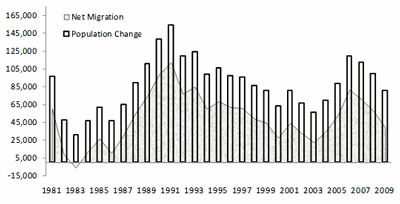The 2009 population estimate, prepared annually by the Office of Financial Management, places Washington state’s population at 6,668,200 as of April 1, 2009. This represents growth of 80,600, or 1.2 percent, over the last year, compared to the most recent annual growth peak of 1.9 percent in 2006.
Growth in Mercer Island’s population, which has been slow for over a decade, rose an estimated 70 residents over last year to 22,720. In 2000, the Island’s population was estimated at 22,036 before dipping in the mid-part of the last decade.
Migration is an important component of our state’s growth, and is largely driven by employment opportunities. While Washington remains more economically attractive than California, Oregon and many other states, population gains due to migration have dropped from 81,000 in 2006 to 58,000 in 2008 and 39,000 for 2009, according to Theresa Lowe, the state’s chief demographer.
“The continued housing contraction nationwide and poor economic conditions appear to be limiting the mobility of the population usually influenced by labor market opportunities,” Lowe said. “Many job seekers are finding it difficult to sell their homes or to relocate to accept employment at the price of paying two mortgages for an extended period.”
Basic market forces throughout the United States have also reduced immigration, and have resulted in many resident and situational immigrants returning home. Washington has relatively large Hispanic and Asian populations, ranking seventh among the states in the number of Asians and 13th in the number of Hispanic/Latinos. The large in and out flows associated with these populations are affected by present economic conditions, another factor resulting in the slowdown of state growth.
The annual population determinations by OFM are based on actual change in school enrollment, housing, voters, driver’s licenses and other indicator data, and are used to distribute revenues to local governments for public services and transportation. These annual figures are also used to develop and validate population forecasts, which help to anticipate changes in population-driven budget expenditures.


